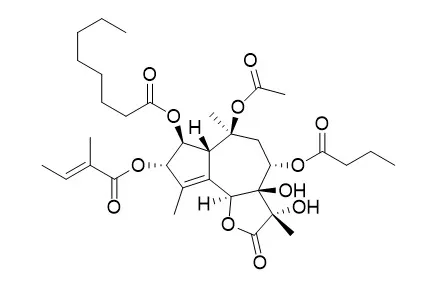| In vitro: |
| Shock . 2017 Apr;47(4):506-513. | | Modeling Acute ER Stress in Vivo and in Vitro[Pubmed: 27755507] | | The endoplasmic reticulum (ER) is a critical organelle that synthesizes secretory proteins and serves as the main calcium storage site of the cell. The accumulation of unfolded proteins at the ER results in ER stress. Although the association between ER stress and the pathogenesis of many metabolic conditions have been well characterized using both in vivo and in vitro models, no standardized model concerning ER stress exists. Here, we report a standardized model of ER stress using two well-characterized ER stress-inducing agents, Thapsigargin and tunicamycin. Our aim in this current study was 2-fold: to characterize and establish which agent is optimal for in vitro use to model acute ER stress and to evaluate which agent is optimal for in vivo use. To study the first aim we used two well-established metabolic cell lines; human hepatocellular carcinoma (HepG2s) and differentiated mouse adipocytes (3T3-L1). In the second aim we utilized C57BL/6J mice that were randomized into three treatment groups of sham, Thapsigargin, and tunicamycin. Our in vitro results showed that tunicamycin worked as a rapid and efficacious inducer of ER stress in adipocytes consistently, whereas Thapsigargin and tunicamycin were equally effective in inducing ER stress in hepatocytes. In regards to our in vivo results, we saw that tunicamycin was superior in not only inducing ER stress but also recapturing the metabolic alterations associated with ER stress. Thus, our findings will help guide and inform researchers as to which ER stress agent is appropriate with regards to their model. | | Brain Res . 2004 Jun 18;1011(2):177-186 | | Differential thapsigargin-sensitivities and interaction of Ca2+ stores in human SH-SY5Y neuroblastoma cells[Pubmed: 15157804] | | In human SH-SY5Y neuroblastoma cells, two distinct intracellular Ca2+ stores, a KCl-/caffeine-sensitive and a carbachol-/IP3-sensitive store, were demonstrated previously. In this study, responses of these two intracellular Ca2+ stores to Thapsigargin were characterized. Ca2+-release from these stores was evoked either by high K+ (100 mM KCl) or by 1 mM carbachol, and changes in the intracellular Ca2+ level were monitored using Fura-2 fluorimetry. A sequential stimulation protocol (KCl-->carbachol or vice versa) allowed evaluation of the individual contribution of different Ca2+ stores to the evoked intracellular Ca2+ ([Ca2+]i)-transients and the dynamic interaction between them. Thapsigargin (0.05 nM - 20 microM) alone induced a [Ca2+]i-transient. Both the carbachol- and the KCl-evoked [Ca2+]i-transients were inhibited by Thapsigargin, but with very different sensitivities. Thapsigargin inhibited the carbachol-evoked [Ca2+]i-transients with (IC50 = 0.353 nM) or without (IC50 = 0.448 nM) a KCl-prestimulation, but an additional small component, with a much lower sensitivity (IC50=4814 nM), was observed in the absence of a KCl-prestimulation. In contrast, the KCl-evoked [Ca2+]i-transients displayed only one component with a very low sensitivity to Thapsigargin in both absence (IC50=3343 nM) and presence (IC50=6858 nM) of a carbachol-prestimulation. These findings suggest that the sarco-/endoplasmic reticular Ca2+ ATPases associated with the KCl-/caffeine- and carbachol-/IP3-sensitive intracellular Ca2+ stores differ from each other, either in types or in their post-translational modification. Such difference might play important role in the regulation of neuronal Ca2+ homeostasis. | | Biochem J . 1995 Jan 15;305 ( Pt 2)(Pt 2):525-528. | | Thapsigargin inhibits Ca2+ entry into human neutrophil granulocytes[Pubmed: 7832770] | | The mechanism of Ca2+ entry after ligand binding to receptors on the surface of non-excitable cells is a current focus of interest. Considerable attention has been given to Ca2+ influx induced by emptying of intracellular pools. Thapsigargin, an inhibitor of microsomal Ca(2+)-ATPase, is an important tool in inducing store-regulated Ca2+ influx. In the present paper we show that, at concentrations above 500 nM, Thapsigargin also has an opposite effect: it inhibits store-regulated Ca2+ influx into Fura-2-loaded human neutrophil granulocytes. As Thapsigargin has been frequently applied at concentrations up to 2 microM, its inhibitory action on plasma-membrane Ca2+ fluxes deserves consideration. |
|
| In vivo: |
| Shock . 2017 Apr;47(4):506-513. | | Modeling Acute ER Stress in Vivo and in Vitro[Pubmed: 27755507] | | The endoplasmic reticulum (ER) is a critical organelle that synthesizes secretory proteins and serves as the main calcium storage site of the cell. The accumulation of unfolded proteins at the ER results in ER stress. Although the association between ER stress and the pathogenesis of many metabolic conditions have been well characterized using both in vivo and in vitro models, no standardized model concerning ER stress exists. Here, we report a standardized model of ER stress using two well-characterized ER stress-inducing agents, Thapsigargin and tunicamycin. Our aim in this current study was 2-fold: to characterize and establish which agent is optimal for in vitro use to model acute ER stress and to evaluate which agent is optimal for in vivo use. To study the first aim we used two well-established metabolic cell lines; human hepatocellular carcinoma (HepG2s) and differentiated mouse adipocytes (3T3-L1). In the second aim we utilized C57BL/6J mice that were randomized into three treatment groups of sham, Thapsigargin, and tunicamycin. Our in vitro results showed that tunicamycin worked as a rapid and efficacious inducer of ER stress in adipocytes consistently, whereas Thapsigargin and tunicamycin were equally effective in inducing ER stress in hepatocytes. In regards to our in vivo results, we saw that tunicamycin was superior in not only inducing ER stress but also recapturing the metabolic alterations associated with ER stress. Thus, our findings will help guide and inform researchers as to which ER stress agent is appropriate with regards to their model. |
|






 Cell. 2018 Jan 11;172(1-2):249-261.e12. doi: 10.1016/j.cell.2017.12.019.IF=36.216(2019)
Cell. 2018 Jan 11;172(1-2):249-261.e12. doi: 10.1016/j.cell.2017.12.019.IF=36.216(2019) Cell Metab. 2020 Mar 3;31(3):534-548.e5. doi: 10.1016/j.cmet.2020.01.002.IF=22.415(2019)
Cell Metab. 2020 Mar 3;31(3):534-548.e5. doi: 10.1016/j.cmet.2020.01.002.IF=22.415(2019) Mol Cell. 2017 Nov 16;68(4):673-685.e6. doi: 10.1016/j.molcel.2017.10.022.IF=14.548(2019)
Mol Cell. 2017 Nov 16;68(4):673-685.e6. doi: 10.1016/j.molcel.2017.10.022.IF=14.548(2019)